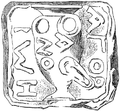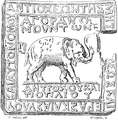Mina (unit)
The mina (also mĕnē, Aramaic; Template:Lang-he-n)[a] is an ancient Near Eastern unit of weight, which was divided into 60 shekels. The mina, like the shekel, was also a unit of currency. In ancient Greece, it originally equalled 70 drachmae and later was increased to 100 drachmae.[1] The Greek word mna (μνᾶ) was borrowed from Semitic;[citation needed] compare Hebrew māneh, Aramaic mĕnē, Syriac manyā, Ugaritic mn, and Akkadian manū.
From earliest Sumerian times, a mina was a unit of weight. At first, talents and shekels had not yet been introduced. By the time of Ur-Nammu, the mina had a value of 1/60 talents as well as 60 shekels. The weight of this mina is calculated at 1.25 pounds (0.57 kg)[2][3].
Writings from Ugarit give the value of a mina as equivalent to fifty shekels.[4] The prophet Ezekiel refers to a mina ('maneh' in the King James Version) also as 60 shekels, in the Book of Ezekiel 45:12. Jesus of Nazareth tells the "parable of the minas" in Luke 19:11-27. In Jewish usage, the maneh is equal in weight to 100 denarii.[5]
From the Akkadian period, 2 mina was equal to 1 sila of water (cf. clepsydra, water clock).
The Greek mina
The Aeginetan mina weighed 623.7 g.[6]
The Attic mina weighed 436.6 g.[7]
Purchasing power
- The price for a slave in Plautus' Pseudolus (191 BCE) was 20 minæ; one mina being, according to the commentator writing in 1912, "about US$18.05, or £3 14s. 4d."[8] $18.05 USD in 1912 would be equivalent to approximately $470 USD in 2019[9][10][failed verification]
- In the first century AD [in Greece?], it amounted to about a fourth of the wages earned annually by an agricultural worker. [citation needed]
Images
-
Mina of Athens.
-
Mina of Chios.
-
Mina of Antiochus IV Epiphanes.
-
Mina of Antioch.
Notes
References
- ^ Aristotle (unknown date). Constitution of the Athenians, 10.2.
- ^ Edwards, Tom. ""Bible Weights, Measures, and Monetary Values", SpiritRestoration.org". Archived from the original on 21 January 2012. Retrieved 28 November 2008.. Calculation of weight by number of shekels.
- ^
 Singer, Isidore; et al., eds. (1901–1906). "Money". The Jewish Encyclopedia. New York: Funk & Wagnalls.
Singer, Isidore; et al., eds. (1901–1906). "Money". The Jewish Encyclopedia. New York: Funk & Wagnalls.
- ^ Tenney, Merril ed., The Zondervan Pictorial Encyclopedia of the Bible, vol. 5, "Weights and Measures," Grand Rapids, MI: Zondervan, 1976.
- ^ Maimonides (1974). Sefer Mishneh Torah - HaYad Ha-Chazakah (Maimonides' Code of Jewish Law) (in Hebrew). Vol. 4 (Seder Avodah). Jerusalem: Pe'er HaTorah., s.v. Hil. Kelei HaMikdash 2:3
- ^ Oleson (1998), p. 764
- ^ Oleson (1998), p. 764
- ^ Perseus Project Ps.1.3
- ^ "US Inflation Calculator". US Inflation Calculator. Retrieved 2019-07-18.
- ^ "The Inflation Calculator". westegg.com. Retrieved 2019-07-18.
Bibliography
- Oleson, John Peter (2008). The Oxford Handbook of Engineering and Technology in the Classical World. Oxford University Press. ISBN 9780199734856.
{{cite book}}: Invalid|ref=harv(help)




